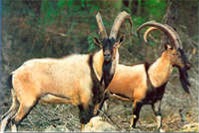

Common Names: wild
goat
Genus: Capra
Species: aegagrus

Capra aegagrus, or Bezoar goats, are found on Creta, and other Greek islands, in Turkey, Iran, Turkmenia, Pakistan. The domestic goat is descended from the Paaang or Bezoar goat.
Bezoar goats vary in size from about 130 to 300 pounds and can get to four feet tall. Their whole body is covered in a coarse wool accept for their legs. The wool can be one color or a combination of colors.
Common colors are black, brown, gray, red, and white. Goats have cloven hooves which means that they are split into two toes. Most wild goats have horns, some curve backwards but others have horns that curve into a corkscrew. Both male and female goats have short beards the same color as their hair. A special feature of the bezoar goat is its scimitar shaped horns with a sharp inside edge.
Wild female and baby goats live together in a pack of about 50, and the males either live by themselves or in an all male pack. During the mating season males give off a oily substance from their skin and this attracts a female. Males often have terrific fights over female. and the winning goat gets to mate.
When females give birth it is to one or two babies, or kids. The kids drink their mothers milk until they are a week old, then they are weaned and start eating the normal foods of a goat.
A special adaptation of a goat is its wool which helps it survive the harsh mountain climate. Another adaptation is its horns, which it uses to defend itself and fight for females.
The Bezoar goat is a herbivore, and its diet consist of grass, twigs, leaves, berries and bark. The goat is prey to a couple different animals, such as wild cats, and Jackals.
Wild goats are listed as vulnerable in the 1996 IUCN Red List of Threatened Animals. An animal is listed as vulnerable when it is not Critically Endangered or Endangered but is facing a high risk of extinction in the wild. The Bezoar goats are losing more and more land to development in their native countries.
by Julius L. 2001
Bibliography:
"Goat", World Book Encyclopedia, 525 W. Monroe Chicago, 1999 (November 3, 2000)
"Animal Info - Greece", http://www.animalinfo.org/country/greece.htm (March 2001)
"Capra aegagrus", http://www.inform.umd.edu/edres/topic/agrenv/ndd/goat (March 2001
"Wild Relatives", http://www.cfhs.ca/Animals&Us/AU2000-2/wild.htm, (June 2001)
"Animal Info - Notes on the Information", http://www.animalinfo.org/notes.htm#vulnerable96, (June 2001)